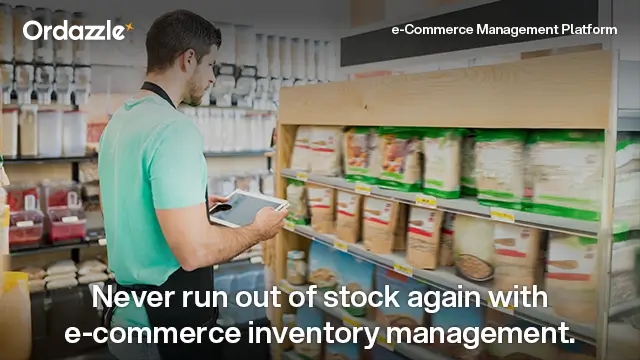What are the Top Inventory Management Techniques in E-Commerce

There are several hundreds of brands in the e-commerce space, and while there are differences between them, they are not that significant in terms of how they operate. When it comes to e-commerce brands in the B2C and D2C space, for instance, products with similar categories tend to be close substitutes. In most cases, then, the service that the brand or seller provides, rather than the product, ends up being the differentiator. This is where having a robust inventory management process flow with effective measures and checks in place makes a huge difference.
Let’s find out how.
Why is inventory management important in e-commerce?
Inventory management is an important element of any retail business, but even more so for e-commerce due to several key reasons. First and foremost, effective inventory management ensures that businesses have the right products available at the right time. It helps prevent stockouts and backorders, which can lead to dissatisfied customers and lost sales opportunities. By maintaining optimal inventory levels, e-commerce companies can meet customer demand promptly and efficiently, enhancing their reputation and customer loyalty.
Furthermore, inventory management plays a vital role in cost control and financial management. Maintaining excessive inventory ties up valuable capital and incurs storage costs, while having insufficient inventory leads to missed sales and potential revenue loss. By implementing effective inventory management techniques such as just-in-time (JIT) inventory or drop-shipping, e-commerce businesses can reduce holding costs, minimise wastage, and improve cash flow.
Another reason inventory management is important in e-commerce is its impact on operational efficiency. By keeping track of stock levels, businesses can streamline their supply chain, optimise order fulfilment, and reduce order processing time. Real-time visibility into inventory allows for accurate demand forecasting and effective replenishment planning, ensuring smooth operations and minimizing delays. Efficient inventory management also enables businesses to identify and eliminate slow-moving or obsolete products, freeing up warehouse space and resources for more profitable items.
Top 3 inventory management techniques in e-commerce in 2023
ABC Analysis
The ABC analysis method of inventory management categorises items based on their importance and value. The technique is based on the Pareto principle, which states that 80% of the effects come from 20% of the causes.
What does this mean?
Well, this method is based on an observation across most e-commerce brands. Even though you may have many products on offer, a small number of products will emerge as best-sellers. This small chunk will eventually end up accounting for the majority of your inventory.
The ABC analysis method involves dividing inventory items into three categories:
A: These are items that are most important to a business in terms of value. Typically, they represent about 20% of the inventory items but account for about 80% of the inventory value.
B: These are second in order of importance. They represent about 30% of the inventory items and account for about 15% of the inventory value.
C: These make up the rear end of the ranking list. They represent about 50% of the inventory items but account for only about 5% of the inventory value.
Once the items are classified into these categories, you can allocate resources accordingly. For example, you can focus on managing the inventory levels of category A items more closely, as they are the most important to the business. Category C items, on the other hand, may not require as much attention, as they are of lower value.
The ABC analysis method is often used in combination with other inventory management techniques, such as just-in-time (JIT) inventory management and economic order quantity (EOQ) analysis, to help businesses optimise their inventory levels and improve their overall efficiency.
Just-in-Time Inventory
Just-in-Time (JIT) inventory management is a method that aims to minimise the costs and waste associated with holding excess inventory. In JIT inventory management, inventory is ordered and received just in time to be used in the production process or to meet customer demand. This approach also helps to minimise the risk of inventory becoming obsolete or damaged, as well as reducing the need for excess handling and storage.
For instance, any brand which works on the made-to-order philosophy will rely on just-in-time inventory management.
Please keep in mind, however, that JIT inventory management does not come without its share of risks. Holding just enough inventory means you don’t have any room for error.
You must have a good understanding of your production or procurement process and the timing and quantity of inventory required to meet customer demand. This requires close coordination between different departments within your company, as well as with suppliers and customers.
Third-Party Logistics
Third-party logistics (3PL) refers to the inventory managementtechnique which involves the outsourcing of the logistics and supply chain management to another company. This type of arrangement will allow you to do what you do best — create the best quality products. You can leave the logistics and supply chain management tasks to a specialist company. It relies on the optimum division of labour, if you will.
Typically, a 3PL provider will take care of tasks such as warehousing, transportation, order fulfilment, and distribution. This is a cost-effective solution as you don’t have to rent out warehouse space and pay for every step in the process separately.
Third-party logistics providers are preferred by brands who are starting off in the e-commerce space as it is the easiest solution to incorporate.
How can the right inventory management technique help your e-commerce business?
With effective inventory management, e-commerce businesses can maintain optimal stock levels, ensuring they have enough product to meet customer demand without tying up excessive capital in unsold goods. Furthermore, the right inventory management technique allows businesses to analyse historical sales data, identify trends, and make informed forecasts about future demand. This forward planning enables businesses to adjust their stock levels proactively, thereby reducing the risk of stockouts or overstocking. As a result, businesses can streamline their operations and increase efficiency, which can lead to improved profitability.
Moreover, well-implemented inventory management techniques can significantly reduce storage and holding costs. By avoiding overstocking, businesses can minimise the expenses associated with storing and maintaining unsold goods. Inversely, by preventing stockouts, businesses can ensure continuous sales, maintain customer satisfaction, and uphold their market reputation. In the fast-paced world of e-commerce, where customers expect quick and reliable delivery, having an effective inventory management system is crucial. It helps businesses to manage their supply chain effectively, meet customer expectations, and ultimately succeed in the competitive e-commerce landscape.
Conclusion
Effective inventory management is a cornerstone of successful e-commerce operations. It requires a fine balance and strategic approach, as both overstocking and understocking can lead to lost sales and increased costs. Techniques such as ABC Analysis, JIT, Drop shipping, or Cross-Docking, and using advanced inventory management software, among others, are critical tools for maintaining this balance. By implementing these techniques, e-commerce businesses can better predict demand, reduce costs, improve order fulfilment, and ultimately enhance customer satisfaction. As the e-commerce landscape continues to evolve, so too will these techniques, necessitating ongoing learning and adaptation on the part of businesses. Mastering these practices can significantly contribute to the sustainability and profitability of an e-commerce venture.


